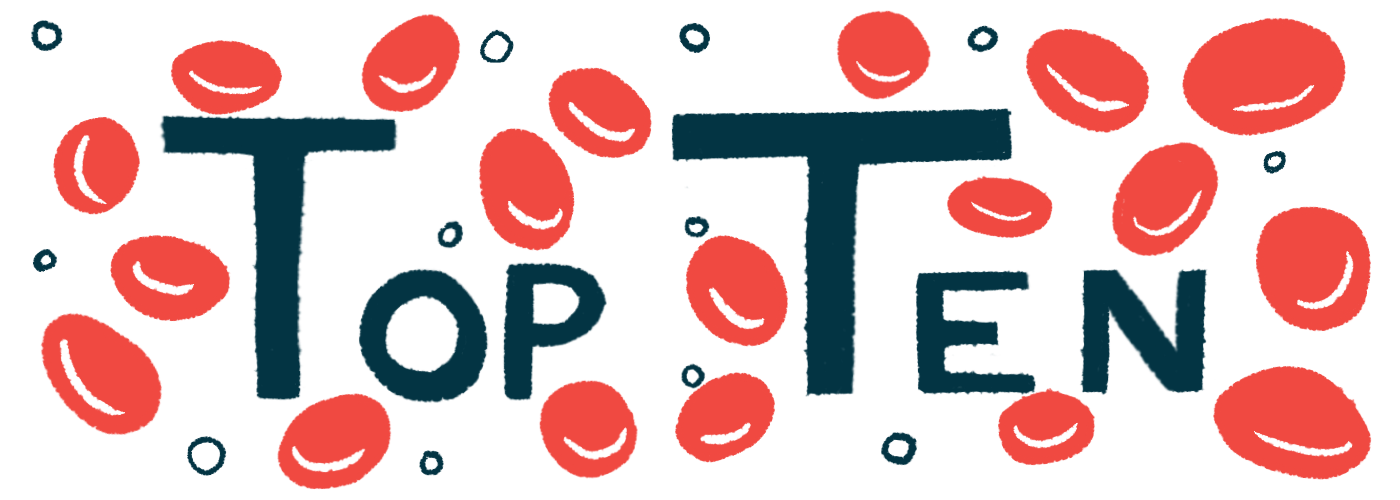Top 10 sickle cell disease stories of 2023
Gene-editing therapies were of particular interest to readers
Written by |

Throughout 2023, Sickle Cell Disease News brought readers coverage of the latest clinical research and scientific breakthroughs related to sickle cell disease (SCD).
Here are the year’s top 10 most-read articles, each with a brief description. We hope to remain a dependable resource for the SCD community in 2024.
No. 10 – $1.9M NIH grant given to improve adherence to hydroxyurea therapy
Hydroxyurea is an oral treatment approved to reduce recurrent pain attacks, called vaso-occlusive crises (VOCs), and the need for blood transfusions in people with SCD. Still, adherence rates among SCD children can be as low as 20%, leading to frequent emergency department visits and in-patient hospitalizations.
The National Institutes of Health has awarded a $1.9 million grant to Scene Health and the Research Institute at Nationwide Children’s Hospital to support a clinical trial called ADHERE, which will evaluate Scene’s technology to improve hydroxyurea adherence. Video-directed observed therapy will monitor, encourage, and measure adherence through daily video exchanges between patients and caregivers and the healthcare team at Scene.
No. 9 – Bluebird provides FDA with manufacturing information on gene therapy
Lovo-cel (lovotibeglogene autotemcel) is a one-time gene therapy developed by Bluebird Bio and now approved and marketed as Lyfgenia in the U.S. It’s designed to insert a functional modified copy of a gene, which is defective in SCD, into patient-derived blood stem cells. The modified stem cells are then returned to the patient and expected to give rise to new red blood cells that produce a working version of hemoglobin, the protein that’s faulty in the disease.
Because the treatment uses a complex manufacturing process, the U.S. Food and Drug Administration (FDA) asked Bluebird Bio for more information to ensure the therapy’s commercial production is comparable to that used in clinical testing. In March, the company provided the agency with such information in advance of its request for lovo-cel’s approval.
No. 8 – New interactive app available to help manage SCD pain
Pinpoint, a new interactive application, will help individuals with SCD understand and communicate their pain attacks to their healthcare team. Developed in collaboration with HPC International and Klein Buendel, this app uses gaming technology to identify different types of SCD-related pain, catering to patients of all ages with a focus on teenagers.
With input from medical experts, teens, and parents of sickle cell patients, the app works on any smartphone and lets patients play games, watch videos, and learn preventive health tips. It requires an annual $9.99 subscription and is available to patients and medical providers.
No. 7 – Fewer sickle-shaped red blood cells with gene therapy
The experimental gene therapy BCH-BB694 reduced the number of red blood cells that produce faulty hemoglobin S, the hallmark of SCD. The therapy also curbed the tendency of these cells to take on a sickle-shaped form, as revealed by single-cell data from seven patients involved in an ongoing Phase 1 clinical trial (NCT03282656).
The new findings suggest that gene therapy is more effective in preventing red blood cell sickling than hydroxyurea, a standard SCD treatment. A Phase 2 trial called GRASP (NCT05353647) is underway to help provide additional insights into the therapeutic potential of BCH-BB694.
No. 6 – Safer way to deliver gene-editing therapy under development
A new approach to delivering gene-editing therapies for blood disorders like SCD has been developed, potentially enhancing treatment safety and lowering costs. Unlike traditional methods that involve the use of chemotherapy before reinfusing edited cells back into the body, this new technique enables patient’s cells to be modified directly within the body, eliminating the need for chemotherapy or radiation therapy.
This innovative approach, jointly developed by researchers at Children’s Hospital of Philadelphia and the Perelman School of Medicine at the University of Pennsylvania, successfully corrected mutations in cells derived from individuals with SCD, raising hemoglobin levels by more than 90%.
No. 5 – Vitamin D or omega-3 supplements help treat VOCs in SCD children
Vitamin D or omega-3 supplements enhanced the therapeutic effectiveness of standard care treatment for children with SCD experiencing VOCs, according to a cost analysis. Although supplementation was linked to a higher use of healthcare resources, its benefits outweighed the additional costs.
Omega-3 supplements reduced the mean number of VOCs compared with standard treatment alone, significantly lessening their severity and reducing the mean number of days spent in the hospital. Vitamin D supplements did not lower the number of VOCs, but reduced their severity and lowered the mean number of days patients spent in the hospital.
No. 4 – UK approves Casgevy, first gene-editing therapy for SCD
In November, regulators in the U.K. conditionally approved the gene-editing therapy exa-cel (exagamglogene autotemcel) — under the brand name Casgevy — for people with SCD and transfusion-dependent beta thalassemia (TDT).
The CRISPR-based treatment is available to SCD patients, 12 and older, with recurrent VOCs or those with TDT who are eligible for a stem cell transplant, but have no available donor. Casgevy, which works to increase the production of fetal hemoglobin in the body, has since been approved for SCD in the U.S. and is currently under review in the European Union for both indications.
No. 3 – Application for US approval of exa-cel completed by Vertex, CRISPR
An application seeking the approval of the gene-editing therapy exa-cel for SCD and TDT in the U.S. was completed by its developers, Vertex Pharmaceuticals and CRISPR Therapeutics, in April. The application was supported by data from two ongoing Phase 1/2/3 trials, one called CLIMB-121 (NCT03745287) involving SCD patients and another called CLIMB–111 (NCT03655678) enrolling TDT patients.
The rolling biologics license application was started in 2022 and included a request for priority review by the FDA, which would shorten the review time from the standard one year to eight months if granted.
No. 2 – FDA grants priority review to exa-cel for SCD
In June, the FDA granted priority review to the application seeking the approval of the gene-editing therapy exa-cel for SCD. The U.S. agency ended up announcing its decision to approve exa-cel for the treatment of SCD on Dec. 8, the previously disclosed anticipated target action date.
The application seeking exa-cel’s approval for TDT is under standard review, with a ruling expected by the end of March 2024.
No. 1 – Stem cell transplant improves health, but emotional challenges remain
A stem cell transplant may improve the physical, mental, and social health of people with SCD, helping them to play sports, travel, and get a job, according to a small study. Still, some challenges can remain, such as emotional struggles and the feeling of being overwhelmed.
In the study, researchers interviewed 10 SCD patients, ages 19-49, who underwent curative stem cell transplants. The procedure eliminates cells in a patient’s bone marrow to make room for stem cells collected from a healthy donor. While the treatment improved the social health in most patients and mental health in some, others experienced emotional struggles and expressed a need for psychological help.
***
At Sickle Cell Disease News, we hope our stories and reporting in 2023 were helpful for those with SCD and their loved ones. We look forward to serving the community further in 2024, seeking to provide ongoing support and up-to-date information.
We wish all our readers a very happy new year!





